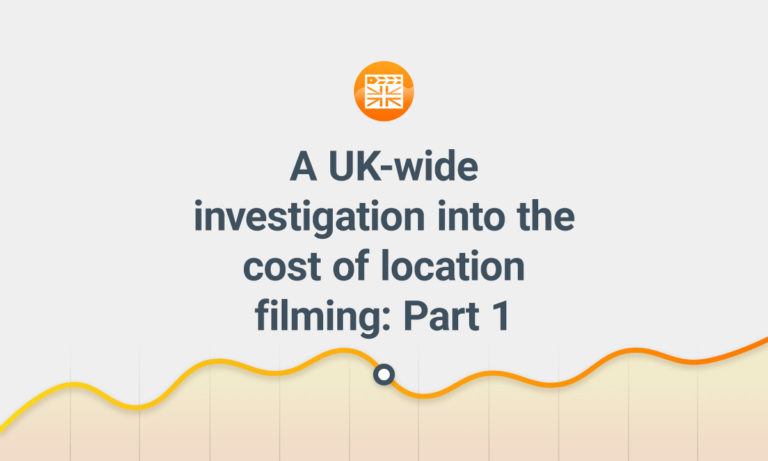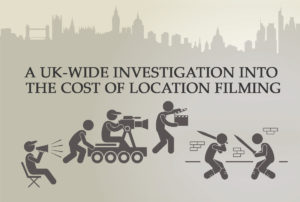 Two weeks ago I shared the data on the economics of location filming in local councils and last week it was museums and galleries. This week it’s the turn of government bodies and the police.
Two weeks ago I shared the data on the economics of location filming in local councils and last week it was museums and galleries. This week it’s the turn of government bodies and the police.
In total, I sent 793 Freedom of Information (FOI) requests to public bodies throughout the UK. The ones I’m addressing today total 272, although only half of those contacted actually provided data (135). The law requires public bodies to comply with FOI requests, although there are a number of exceptions (see more about that here).
For example, all branches of the Armed Forces refused to answer on the grounds that it would take them too long to do the maths (or “It has been estimated that the cost of complying with your requests aggregated under the Fees Regulations as explained above would exceed the appropriate limit and therefore under the terms of Section 12 of the Act, we are not obliged to comply” as they put it).
Headline figures
Within the 135 public bodies that complied with the request are police forces, government departments (both ministerial and non-ministerial), executive agencies, a leisure trust and Transport for London. Together they raised £9,526,698 via filming (almost £11 million when adjusted for inflation to 2016 pounds).
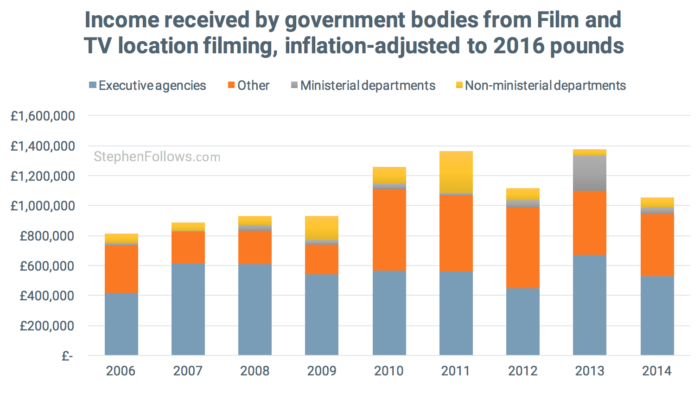
Government departments and executive agencies
Of the FOI requests I sent to government departments and executive agencies, 105 replied and 22% of those who answered my questions declared that they had received at least some money from filming in the past decade.
The highest earner was the Royal Park Agency, who earned a whopping £3,980,285 over a ten-year period.
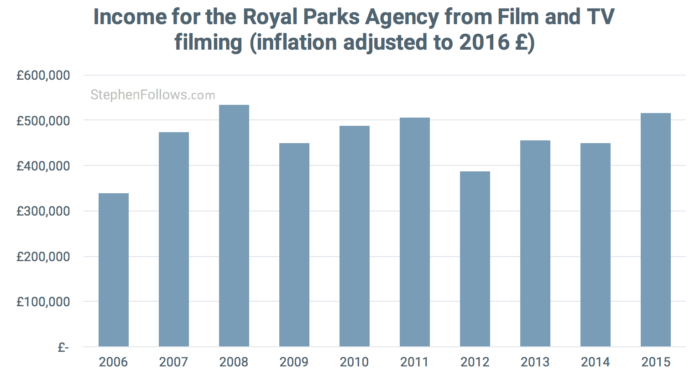
The government department with the highest average annual income was the Foreign and Commonwealth Office, have earned almost half a million pounds in just three years (2013-15). Their income pattern is unusual in that out of the five years they gave me data for, three had zero income. The other two (2013 and 2015) had £163,860 and £295,333, respectively.
Below is the full list of government departments (ministerial and non-ministerial) and executive agencies with income from film and television…
- £3,980,285 (2006-15) – Royal Parks Agency
- £790,879 (2006-15) – Forestry Commission
- £604,385 (2006-15) – Historic Scotland
- £459,193 (2011-15) – Foreign and Commonwealth Office
- £191,544 (2006-15) – National Archives
- £120,815 (2006-15) – Department of Agriculture and Rural Development (Northern Ireland)
- £91,630 (2007-15) – Queen Elizabeth II Conference Centre
- £63,692 (2008-15) – Office of the First Minister and Deputy First Minister (Northern Ireland)
- £53,054 (2006-15) – Scottish Government
- £36,559 (2006-15) – Department for Regional Development (Northern Ireland)
- £34,950 (2012-14) – Department of the Environment (Northern Ireland)
- £29,139 (2006-15) – National Records of Scotland
- £21,010 (2011-15) – Scottish Court Service
- £13,775 (2011-15) – Department of Energy and Climate Change
- £9,300 (2006-15) – Her Majesty’s Treasury
- £7,565 (2006-15) – Keeper of the Registers of Scotland
- £6,520 (2006-15) – Northern Ireland Assembly
- £5,000 (2006-15) – Scotland Office
- £3,742 (2006-15) – National Measurement Office
- £1,125 (2006-15) – Land Registry
The police
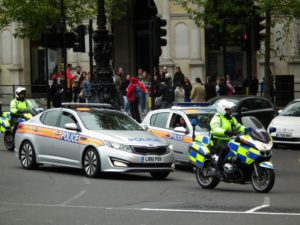 The police force that earned by far and away the largest income from film and television productions is the Metropolitan Police (“the Met”). This is unsurprising as over two-thirds of film production jobs are in London and the South East (see here for a previous research project I conducted which looked into the London-centric nature of the UK film industry).
The police force that earned by far and away the largest income from film and television productions is the Metropolitan Police (“the Met”). This is unsurprising as over two-thirds of film production jobs are in London and the South East (see here for a previous research project I conducted which looked into the London-centric nature of the UK film industry).
The Met were fully within their rights to reject my FOI request due to the volume of work it would have taken to answer it. Eight other forces took this approach (Avon and Somerset Constabulary, Gloucestershire Constabulary, Humberside Police, Kent Police, Merseyside Police, North Wales Police, Police Scotland and West Midlands Police) but instead the Met Police agreed to help informally. They provided data for the past few years, on condition that I co-mingle the data with that of other forces.
Therefore, I cannot provide a full data table for police income as I have done for other types of organisations. But I can say that during the three years between 2013-15, UK Police forces earned a total of at least £1,764,827 from film and television productions.
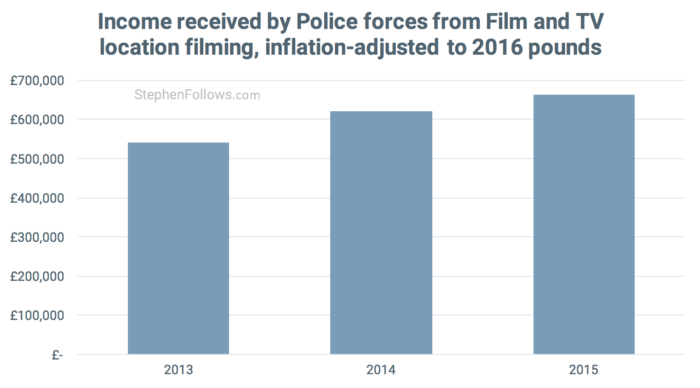
The costs of having Met Police officers on set varies depending on their seniority. Below are the rates charged to productions for a standard eight-hour day…
- Assistant Commissioner – £1,711
- Deputy Assistant Commissioner – £1,217
- Commander – £886
- Chief Superintendent – £724
- Superintendent – £639
- Chief Inspector – £546
- Inspector – £517
- Sergeant – £538 (£807 on public holidays)
- Constable – £450 (£675 on public holidays)
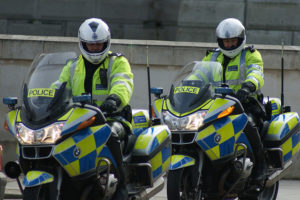 The Met isn’t just made up of humans. If you wish to hire any of their animal or vehicular companions then the following charges apply…
The Met isn’t just made up of humans. If you wish to hire any of their animal or vehicular companions then the following charges apply…
- Horses – £170.70 per day (plus any extra expenses incurred for their conveyance and stabling)
- Dogs – £63.40 per day (plus any extra expenses incurred for their conveyance)
- Marked motorcycles – Between £59.20 (100cc to 600cc) and £94.90 (over 600cc)
- Marked cars – Between £88.70 (under 1300cc) up to £128.50 (over 1800cc)
- Marked vans – Between £128.50 (under 1900cc) up to £137.70 (over 1900cc)
- Ballistically Protected 4×4 vehicle – £191.80
Note: These are the costs at the time of writing and are regularly revised.
Transport for London (TfL)
Transport for London manages the capital’s Underground (“the Tube”), Overground rail services, buses and river services. Historically, film requests have been handled separately but TfL are currently in the process of centralising management of film and television products across their network. This is great for filmmakers in the future but makes tracking down historical data tricky.
The Tube is TfL’s largest driver of income from film and television productions, generating £3,284,000 in the past decade.
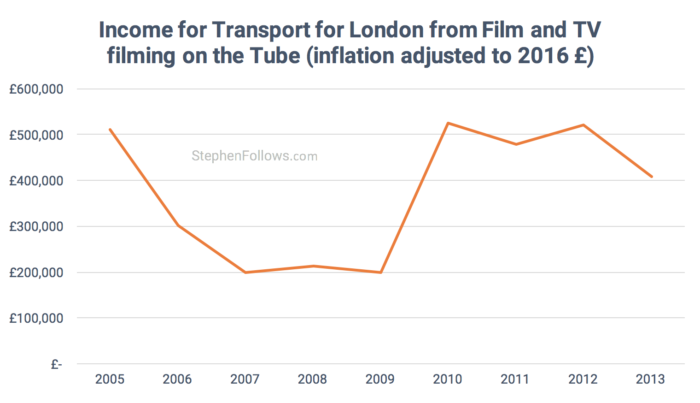
Here is a summary of the data I found for other TfL services…
 Buses – Most filming on buses is achieved by hiring a bus from a private company, so TfL don’t have much cause to manage film requests on their own buses. If filming does occur on TfL-managed busses then there is no fee for the permit, although the production company will need to reimburse TfL for any costs, such as any additional staff needed, closing bus stops and any diversion signage.
Buses – Most filming on buses is achieved by hiring a bus from a private company, so TfL don’t have much cause to manage film requests on their own buses. If filming does occur on TfL-managed busses then there is no fee for the permit, although the production company will need to reimburse TfL for any costs, such as any additional staff needed, closing bus stops and any diversion signage.- River services – Between 2006 and 2015, TfL earned £29,749 from filming on and around its river services.
- Docklands Light Railway (DLR) – Prior to 2015, filming on the DLR was managed by an outside company (Serco Docklands), who also kept income from filming. As they are a private company, we cannot use the FOI Act to uncover how much they’ve raised. However, now that TfL are managing filming we know that in 2015 the DLR charged filmmakers a total of £31,937.
- London Overground – TfL say “Very little money has been received for filming” on their rail services and that they “do not hold details of the any such revenue received“. Small productions (i.e. those with fewer than six people and only using hand-held equipment) can apply for a three-hour permit at a cost of £300. For larger productions they charge £350 per hour for filming at stations and £400 per hour for filming on trains.
- London streets – TfL shares responsibilities for London’s roads with the Highways Agency and London’s 32 boroughs. From mid-2012, TfL’s Events and Filming Team took over the management of filming on the Transport for London Road Network (TLRN). They don’t charge a fee and only look to recover costs for staff time, resources and other such expenses. TfL say that they don’t seek to recover costs from “smaller scale” productions.
- London Trams – In the ten years I was studying, TfL only report one instance of filming on their trams, so cannot share the financial detail behind it (to protect the commercial sensitivity of that production).
- Other TfL services – TfL acknowledged to me that there may have been money earned from filming on their other services (such as in Victoria Coach Station or on the Emirates Airline) but as it’s not centrally managed, it’s not possible for them to be sure.
The cost of providing services for the film and television industries
When I approached the public bodies I also asked them how much they have spent facilitating location filming. Many refused to answer, most commonly because they did not calculate it internally.
The few bodies who did provide a breakdown of costs revealed the same pattern I found last week when looking at museums and galleries – namely, that the vast majority of money charged is profit. Here are a few examples…
- The costs of the London Underground Film Office are relatively small; in the five years between 2001 and 2015 it cost £150,976. Over the same period, they generated £1,719,000 of income – a 91% profit margin.
- The Royal Parks Agency raised £3,980,285 in the ten years between 2006-15, with a profit margin of around 88%.
- The Forestry Commission raised £790,379 over the same period, with a margin of 98%.
- The Met Police don’t charge any kind of mark-up, so all of their film location services are provided at cost.
- The City of London Police do appear to charge a markup but it is minor when compared to other public bodies. Between 2006 and 2014, their film and television filming services made a profit of 36%.
Full list of governmental bodies’ income
Below is the data I received from the governmental bodies which provided answers to my Freedom of Information requests. These figures are in GB pounds, are as provided and have not been adjusted for inflation. If an entry says ‘£-’ then this means that they did not receive any money that year from location filming, whereas ‘n/a’ means they did not provide data. As previously mentioned, I have had to co-mingle all data from Police forces into one entry, due to an agreement with the Met Police.
| Public Body | '06 | '07 | '08 | '09 | '10 | '11 | '12 | '13 | '14 | '15 | 06-15 |
|---|---|---|---|---|---|---|---|---|---|---|---|
| Royal Parks Agency | £250,506 | £362,258 | £427,266 | £373,948 | £403,289 | £436,679 | £352,502 | £425,992 | £436,245 | £511,600 | £3,980,285 |
| ALL POLICE WITH INCOME (see note) | £88,617 | £263,425 | £116,773 | £140,488 | £227,421 | £189,810 | £216,157 | £505,802 | £600,881 | £656,388 | £3,005,761 |
| Transport for London | £231,645 | £162,679 | £179,238 | £165,870 | £452,740 | £438,260 | £489,504 | £396,000 | £402,079 | £48,671 | £2,966,686 |
| Forestry Commission | £41,125 | £40,860 | £46,775 | £133,456 | £86,106 | £233,520 | £61,480 | £36,477 | £62,920 | £47,660 | £790,379 |
| Historic Scotland | £50,398 | £94,114 | £45,580 | £53,204 | £39,759 | £21,097 | £19,659 | £125,326 | £47,068 | £108,181 | £604,385 |
| Foreign and Commonwealth Office | n/a | n/a | n/a | n/a | n/a | £- | £- | £163,860 | £- | £295,333 | £459,193 |
| National Archives | £10,125 | £11,270 | £13,925 | £20,983 | £13,083 | £21,175 | £17,598 | £30,175 | £22,275 | £30,935 | £191,544 |
| Department of Agriculture and Rural Development (Northern Ireland) | £5,900 | £170 | £2,510 | £14,015 | £19,820 | £170 | £8,680 | £23,350 | £13,010 | £33,190 | £120,815 |
| Queen Elizabeth II Conference Centre | n/a | £- | £215 | £774 | £7,613 | £1,818 | £19,429 | £46,447 | £4,200 | £11,134 | £91,630 |
| Office of the First Minister and Deputy First Minister (Northern Ireland) | n/a | n/a | £22,766 | £7,344 | £- | £8,450 | £5,000 | £- | £- | £20,132 | £63,692 |
| Scottish Government | £10,300 | £1,775 | £1,625 | £3,220 | £2,800 | £3,336 | £8,280 | £1,060 | £4,078 | £16,581 | £53,054 |
| Department for Regional Development (Northern Ireland) | £280 | £4,440 | £1,284 | £1,120 | £8,770 | £4,997 | £6,006 | £4,386 | £3,859 | £1,417 | £36,559 |
| Department of the Environment (Northern Ireland) | n/a | n/a | n/a | n/a | n/a | n/a | £7,000 | £19,000 | £8,950 | n/a | £34,950 |
| National Records of Scotland | £3,529 | £1,953 | £2,891 | £3,190 | £1,938 | £4,589 | £5,730 | £2,720 | £1,380 | £1,220 | £29,139 |
| Scottish Court Service | n/a | n/a | n/a | n/a | n/a | £2,103 | £1,680 | £5,384 | £6,361 | £5,482 | £21,010 |
| Department of Energy and Climate Change | n/a | n/a | n/a | n/a | n/a | £- | £- | £4,400 | £2,700 | £6,675 | £13,775 |
| Her Majesty’s Treasury | £- | £- | £- | £- | £- | £- | £- | £- | £5,400 | £3,900 | £9,300 |
| Keeper of the Registers of Scotland | £- | £- | £- | £- | £- | £345 | £3,595 | £2,627 | £133 | £865 | £7,565 |
| Northern Ireland Assembly | £- | £- | £- | £- | £- | £- | £2,500 | £- | £- | £4,020 | £6,520 |
| Scotland Office | £- | £- | £- | £- | £- | £- | £5,000 | £- | £- | £- | £5,000 |
| National Measurement Office | £- | £- | £- | £- | £1,786 | £- | £496 | £- | £1,460 | £- | £3,742 |
| Land Registry | £- | £- | £- | £600 | £525 | £- | £- | £- | £- | £- | £1,125 |
| Department of Justice (Northern Ireland) | £- | £- | £- | £- | £- | £- | £- | £- | £- | £- | £- |
| Office of Rail and Road | £- | £- | £- | £- | £- | £- | £- | £- | £- | £- | £- |
| Marine and Fisheries Agency | £- | £- | £- | £- | £- | £- | £- | £- | £- | £- | £- |
| Belfast Harbour Police | £- | £- | £- | £- | £- | £- | £- | £- | £- | £- | £- |
| British Transport Police | £- | £- | £- | £- | £- | £- | £- | £- | £- | £- | £- |
| Cambridgeshire Constabulary | £- | £- | £- | £- | £- | £- | £- | £- | £- | £- | £- |
| Cheshire Constabulary | £- | £- | £- | £- | £- | £- | £- | £- | £- | £- | £- |
| Civil Nuclear Constabulary | £- | £- | £- | £- | £- | £- | £- | £- | £- | £- | £- |
| Cumbria Constabulary | £- | £- | £- | £- | £- | £- | £- | £- | £- | £- | £- |
| Devon and Cornwall Constabulary | £- | £- | £- | £- | £- | £- | £- | £- | £- | £- | £- |
| Dyfed Powys Police | £- | £- | £- | £- | £- | £- | £- | £- | £- | £- | £- |
| Gwent Police | £- | £- | £- | £- | £- | £- | £- | £- | £- | £- | £- |
| Leicestershire Constabulary | £- | £- | £- | £- | £- | £- | £- | £- | £- | £- | £- |
| Northamptonshire Police | £- | £- | £- | £- | £- | £- | £- | £- | £- | £- | £- |
| Nottinghamshire Police | £- | £- | £- | £- | £- | £- | £- | £- | £- | £- | £- |
| Port of Bristol Police | £- | £- | £- | £- | £- | £- | £- | £- | £- | £- | £- |
| Port of Portland Police | £- | £- | £- | £- | £- | £- | £- | £- | £- | £- | £- |
| Royal Ulster Constabulary George Cross Foundation | £- | £- | £- | £- | £- | £- | £- | £- | £- | £- | £- |
| South Yorkshire Police | £- | £- | £- | £- | £- | £- | £- | £- | £- | £- | £- |
| Staffordshire Police | £- | £- | £- | £- | £- | £- | £- | £- | £- | £- | £- |
| Suffolk Constabulary | £- | £- | £- | £- | £- | £- | £- | £- | £- | £- | £- |
| Surrey Police | £- | £- | £- | £- | £- | £- | £- | £- | £- | £- | £- |
| Sussex Police | £- | £- | £- | £- | £- | £- | £- | £- | £- | £- | £- |
| Warwickshire Police | £- | £- | £- | £- | £- | £- | £- | £- | £- | £- | £- |
| West Mercia Police | £- | £- | £- | £- | £- | £- | £- | £- | £- | £- | £- |
| Wiltshire Constabulary | £- | £- | £- | £- | £- | £- | £- | £- | £- | £- | £- |
| Attorney General’s Office | £- | £- | £- | £- | £- | £- | £- | £- | £- | £- | £- |
| Department for Communities and Local Government | £- | £- | £- | £- | £- | £- | £- | £- | £- | £- | £- |
| Department for Culture, Arts and Leisure (Northern Ireland) | £- | £- | £- | £- | £- | £- | £- | £- | £- | £- | £- |
| Department for Education | £- | £- | £- | £- | £- | £- | £- | £- | £- | £- | £- |
| Department for International Development | £- | £- | £- | £- | £- | £- | £- | £- | £- | £- | £- |
| Department for Social Development (Northern Ireland) | £- | £- | £- | £- | £- | £- | £- | £- | £- | £- | £- |
| Department of Education (Northern Ireland) | £- | £- | £- | £- | £- | £- | £- | £- | £- | £- | £- |
| Department of Enterprise, Trade and Investment (Northern Ireland) | £- | £- | £- | £- | £- | £- | £- | £- | £- | £- | £- |
| Department of Finance and Personnel (Northern Ireland) | £- | £- | £- | £- | £- | £- | £- | £- | £- | £- | £- |
| Department of Health | £- | £- | £- | £- | £- | £- | £- | £- | £- | £- | £- |
| Department of Health, Social Services and Public Safety (Northern Ireland) | £- | £- | £- | £- | £- | £- | £- | £- | £- | £- | £- |
| Export Credits Guarantee Department | £- | £- | £- | £- | £- | £- | £- | £- | £- | £- | £- |
| Her Majesty’s Inspector of Education | £- | £- | £- | £- | £- | £- | £- | £- | £- | £- | £- |
| Northern Ireland Office | £- | £- | £- | £- | £- | £- | £- | £- | £- | £- | £- |
| Office of the Accountant in Bankruptcy | £- | £- | £- | £- | £- | £- | £- | £- | £- | £- | £- |
| Science & Advice for Scottish Agriculture | £- | £- | £- | £- | £- | £- | £- | £- | £- | £- | £- |
| Scottish Housing Regulator | £- | £- | £- | £- | £- | £- | £- | £- | £- | £- | £- |
| Scottish Parliament | £- | £- | £- | £- | £- | £- | £- | £- | £- | £- | £- |
| Scottish Prison Service | £- | £- | £- | £- | £- | £- | £- | £- | £- | £- | £- |
| Scottish Public Pensions Agency | £- | £- | £- | £- | £- | £- | £- | £- | £- | £- | £- |
| Student Awards Agency for Scotland | £- | £- | £- | £- | £- | £- | £- | £- | £- | £- | £- |
| Wales Office / Swyddfa Cymru | £- | £- | £- | £- | £- | £- | £- | £- | £- | £- | £- |
| Charity Commission for England and Wales | £- | £- | £- | £- | £- | £- | £- | £- | £- | £- | £- |
| Chief Medical Officer of the Scottish Administration | £- | £- | £- | £- | £- | £- | £- | £- | £- | £- | £- |
| Children’s Commissioner for England | £- | £- | £- | £- | £- | £- | £- | £- | £- | £- | £- |
| Competition and Markets Authority | £- | £- | £- | £- | £- | £- | £- | £- | £- | £- | £- |
| Crown Office and Procurator Fiscal (Scotland) | £- | £- | £- | £- | £- | £- | £- | £- | £- | £- | £- |
| Crown Prosecution Service | £- | £- | £- | £- | £- | £- | £- | £- | £- | £- | £- |
| Food Standards Scotland | £- | £- | £- | £- | £- | £- | £- | £- | £- | £- | £- |
| Government Actuary’s Department | £- | £- | £- | £- | £- | £- | £- | £- | £- | £- | £- |
| Government Legal Department | £- | £- | £- | £- | £- | £- | £- | £- | £- | £- | £- |
| Her Majesty’s Chief Inspector of Prosecution in Scotland | £- | £- | £- | £- | £- | £- | £- | £- | £- | £- | £- |
| Her Majesty’s Inspector of Constabulary for Scotland | £- | £- | £- | £- | £- | £- | £- | £- | £- | £- | £- |
| HM Revenue and Customs | £- | £- | £- | £- | £- | £- | £- | £- | £- | £- | £- |
| Office for Standards in Education, Children’s Services and Skills | £- | £- | £- | £- | £- | £- | £- | £- | £- | £- | £- |
| Office of Gas and Electricity Markets | £- | £- | £- | £- | £- | £- | £- | £- | £- | £- | £- |
| Office of Water Services | £- | £- | £- | £- | £- | £- | £- | £- | £- | £- | £- |
| Queen’s Printer for Scotland | £- | £- | £- | £- | £- | £- | £- | £- | £- | £- | £- |
| Revenue Scotland | £- | £- | £- | £- | £- | £- | £- | £- | £- | £- | £- |
| Scottish Environment Protection Agency | £- | £- | £- | £- | £- | £- | £- | £- | £- | £- | £- |
| Serious Fraud Office | £- | £- | £- | £- | £- | £- | £- | £- | £- | £- | £- |
| UK Statistics Authority | £- | £- | £- | £- | £- | £- | £- | £- | £- | £- | £- |
| Animal and Plant Health Agency | £- | £- | £- | £- | £- | £- | £- | £- | £- | £- | £- |
| Centre for Environment, Fisheries and Aquaculture Science | £- | £- | £- | £- | £- | £- | £- | £- | £- | £- | £- |
| Companies House | £- | £- | £- | £- | £- | £- | £- | £- | £- | £- | £- |
| Education Funding Agency | £- | £- | £- | £- | £- | £- | £- | £- | £- | £- | £- |
| Forensic Science Agency Northern Ireland | £- | £- | £- | £- | £- | £- | £- | £- | £- | £- | £- |
| Forest Research | £- | £- | £- | £- | £- | £- | £- | £- | £- | £- | £- |
| Her Majesty’s Chief Inspector of Prisons for Scotland | £- | £- | £- | £- | £- | £- | £- | £- | £- | £- | £- |
| Insolvency Service | £- | £- | £- | £- | £- | £- | £- | £- | £- | £- | £- |
| Intellectual Property Office | £- | £- | £- | £- | £- | £- | £- | £- | £- | £- | £- |
| Medicines and Healthcare products Regulatory Agency | £- | £- | £- | £- | £- | £- | £- | £- | £- | £- | £- |
| Meteorological Office | £- | £- | £- | £- | £- | £- | £- | £- | £- | £- | £- |
| Northern Ireland Prison Service | £- | £- | £- | £- | £- | £- | £- | £- | £- | £- | £- |
| Office of the Advocate General for Scotland | £- | £- | £- | £- | £- | £- | £- | £- | £- | £- | £- |
| Ordnance Survey | £- | £- | £- | £- | £- | £- | £- | £- | £- | £- | £- |
| Planning Inspectorate | £- | £- | £- | £- | £- | £- | £- | £- | £- | £- | £- |
| Public Health England | £- | £- | £- | £- | £- | £- | £- | £- | £- | £- | £- |
| Royal Mint | £- | £- | £- | £- | £- | £- | £- | £- | £- | £- | £- |
| Rural Payments Agency | £- | £- | £- | £- | £- | £- | £- | £- | £- | £- | £- |
| Scottish Criminal Cases Review Commission | £- | £- | £- | £- | £- | £- | £- | £- | £- | £- | £- |
| Skills Funding Agency | £- | £- | £- | £- | £- | £- | £- | £- | £- | £- | £- |
| The Office of the Scottish Charity Regulator | £- | £- | £- | £- | £- | £- | £- | £- | £- | £- | £- |
| Transport Scotland | £- | £- | £- | £- | £- | £- | £- | £- | £- | £- | £- |
| UK Debt Management Office | £- | £- | £- | £- | £- | £- | £- | £- | £- | £- | £- |
| UK Space Agency | £- | £- | £- | £- | £- | £- | £- | £- | £- | £- | £- |
| Valuation Office Agency | £- | £- | £- | £- | £- | £- | £- | £- | £- | £- | £- |
| Veterinary Medicines Directorate | £- | £- | £- | £- | £- | £- | £- | £- | £- | £- | £- |
| Youth Justice Agency for Northern Ireland | £- | £- | £- | £- | £- | £- | £- | £- | £- | £- | £- |
Notes on the economics of location filming
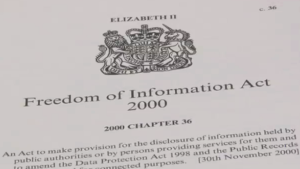 Last week I shared part one of this multi-part research project. That article included details of the Freedom of Information Act, my methodology and a number of notes and caveats. It’s worth having a read of them if you’re planning on using today’s research as most also apply here.
Last week I shared part one of this multi-part research project. That article included details of the Freedom of Information Act, my methodology and a number of notes and caveats. It’s worth having a read of them if you’re planning on using today’s research as most also apply here.
Unless stated otherwise, figures are raw, as provided and exclusive of VAT. When looking at figures over time, or when providing multi-year totals, I have sometimes adjusted for inflation to bring all figures to 2016 UK pounds. In all such cases, I have explicitly mentioned the adjustment.
Epilogue
 This project has taught me a lot about how the UK operates and is managed. The pedant in me had a field day. For example, I spotted that the government department which deals with education in England and Wales is called the Department for Education, whereas in Northern Ireland it’s called the Department of Education (Northern Ireland). My natural pedantry caused me to wonder – why does one use a different preposition to the other? (i.e. ‘of’ and ‘for’).
This project has taught me a lot about how the UK operates and is managed. The pedant in me had a field day. For example, I spotted that the government department which deals with education in England and Wales is called the Department for Education, whereas in Northern Ireland it’s called the Department of Education (Northern Ireland). My natural pedantry caused me to wonder – why does one use a different preposition to the other? (i.e. ‘of’ and ‘for’).
I asked the DoE and a civil servant explained “The DENI in Northern Ireland is focussed solely with education, whereas the Department for Education in England are responsible for education and children’s services“. So the former is made up entirely of education services whereas the latter does all sorts of things to support education. Phew – this was a problem which would have bothered me for years had a kindly fellow not put me out of my misery.
Of all the types of organisations I dealt with, the strangest were the police forces. Some were extremely helpful (the Met took me out for tea!) while others were awkward and unhelpful. Some seemed unable to explain things in a simple manner, for example, when Warwickshire Police & West Mercia Police needed to say “£0” they instead said “Please be advised that FOI deals only with recorded information, and there is no information recorded in relation to your request. Income received would have been recorded“.
Perhaps more worryingly, emails from a few police forces used the much derided font Comic Sans, including Cheshire Constabulary whose entire email (legal disclaimers and all) used the childlike font.

